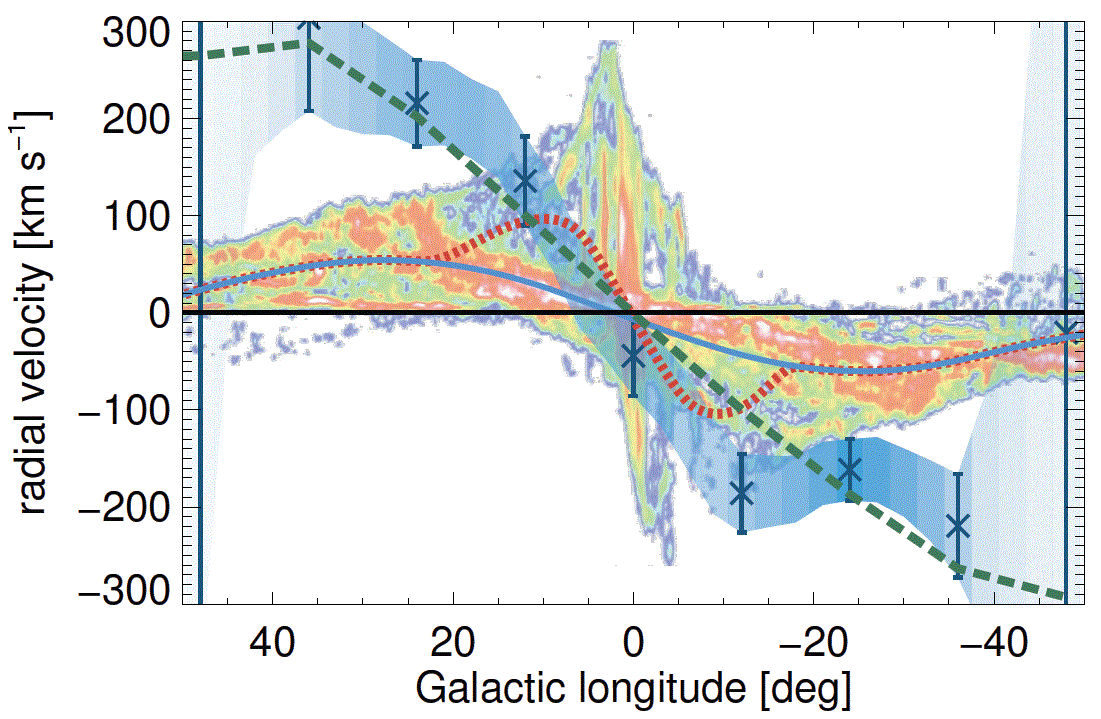Gamma-ray lines from long-lived radioactive isotopes
The radioactive isotopes 26Al and 60Fe are produced and ejected into the interstellar medium by massive stars. With lifetimes on the order of 106 years, comparable to the evolutionary time scales of the OB associations and the stars contained within, the isotopes’ presence traces the regions where massive stars formed recently. The nuclear origin of the gamma-ray lines emitted in the decay of these tracers allows the measurement of the hot component of the interstellar medium occurring in superbubbles, unbiased by the ionisation state of the gas. The gas carrying the radioactive tracers interacts with neighbouring molecular gas, where new star formation episodes can be triggered.
In the nearby star forming regions Orion and Scorpius-Centaurus, the interaction between stellar outflow and surrounding molecular clouds can be observed by mapping the distribution of 26Al in the interior and along the walls of the cavities in the interstellar medium. By mapping the Galactic Plane, we can see at which locations in the spiral structure star formation happens and where the large-scale outflow from these regions transports matter, energy and momentum within the Galactic disc.
Required instrument performances:
If ΔE/E < 0.2% (comparable to SPI), we can resolve an additional degree of freedom (Doppler line broadening). Without this capability, improved angular mapping must compensate the lack of kinematic mapping, requiring higher sensitivity for resolving smaller features.
In the nearby star forming regions Orion and Scorpius-Centaurus, the interaction between stellar outflow and surrounding molecular clouds can be observed by mapping the distribution of 26Al in the interior and along the walls of the cavities in the interstellar medium. By mapping the Galactic Plane, we can see at which locations in the spiral structure star formation happens and where the large-scale outflow from these regions transports matter, energy and momentum within the Galactic disc.

Longitude-velocity diagram comparing velocities measured with INTEGRAL/SPI from the line shape of the 1808.63 keV gamma-ray line from 26Al decay (blue crosses and associated shaded region) with velocities from other tracers. The colour scale shows the velocity distribution of the CO-traced molecular gas along the Galactic ridge. The blue solid, red dotted, and green dashed lines show predictions of various models. Remarkably, the interstellar gas carrying 26Al moves at higher velocities on a large scale than does the CO-traced molecular gas. Credit: K. Kretschmer et al. 2013, A&A 559, A99
|
Required instrument performances:
If ΔE/E < 0.2% (comparable to SPI), we can resolve an additional degree of freedom (Doppler line broadening). Without this capability, improved angular mapping must compensate the lack of kinematic mapping, requiring higher sensitivity for resolving smaller features.
| Performance parameter | Goal value | Remarks and notes |
|
Field-of-view (FWHM, deg) |
40 | Cover Sco-Cen, Orion, Cygnus |
|
Angular resolution (FWHM, deg) |
< 3 | Superbubbles at 4 kpc |
|
Spectral resolution (ΔE/E @ Energy) |
0.16% | Detect Doppler broadening at 100 km s-1 |
|
Line sensitivity (@ Energy) (cm-2 s-1, 3σ, 1 Ms) |
6 × 10-7 if ΔE/E < 0.2% 10-7 if ΔE/E > 0.5% |
Detect Doppler broadening for 50 deg2 regions resolve 20 deg2 regions |
|
Continuum sensitivity (in which energy band?) (cm-2 s-1 keV-1, ΔE=E, 3σ, 1 Ms) |
no constraint | |
| Timing performances | no constraint | |
|
Polarimetric capability (Minimum Polarization Fraction for a Crab source in 1 Ms) |
no constraint | |
| Real-time data? | no constraint |
 AstroMeV
AstroMeV